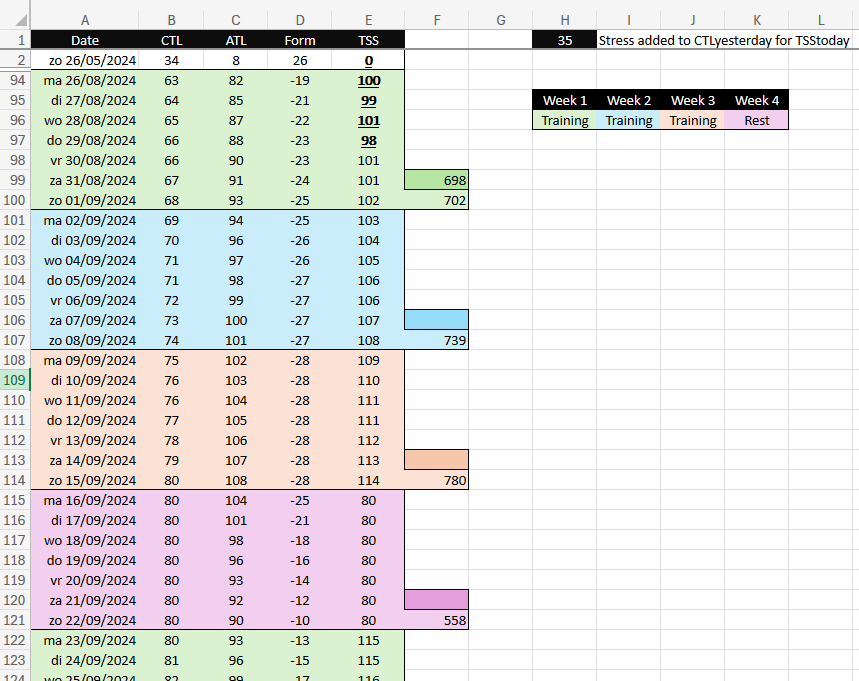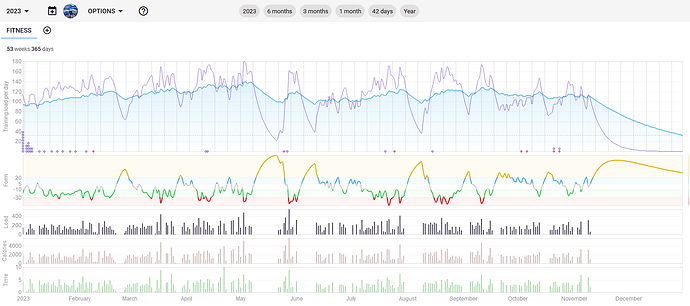Hello cycling friends,
I’ve been cycling a lot the past few years, reaching a peak fitness (CTL) of 130 last year. I didn’t do any structured training and mostly did outdoor rides + Zwift zone 2 and races. My form mostly stayed out of the red and I handled the load easily.
After a 8 month break of cycling I started again at the end of june, raising my fitness but being in the high risk zone too much.
Last week I decided to have a more structured cycling life and building my fitness without going in the high risk zone again. My plan is to aim for a ±5 CTL increase each week. After doing the calculations I discovered my form will reach a limit of -28/-29, staying at this value for a whole week in the 3rd week.
People experienced with this: is this an OK thing? Since I’m not going into the high risk zone, but staying at the risk border doesn’t look good either? I understand the form thresholds are not really borders, but more a transitional area.
I don’t know If my plan wil work, or it will be too much.
PS: My plan is not to keep aiming for the calculated TSS, I will have days with lower and higher depending on the workout.
Thank you in advance for your insights.
Did you try the calculation when starting a bit lower and incrementing ~10% in total weekly load?
Your actual fitness indicates a weekly load of ~65 x 7 = 460. Ramping up immediately to 700 a week is probably the cause of the rapid Form drop.
I would suggest 500 - 560 - 630 followed by a rest week. That’s a bit over 10% increment but given your history, that should be safe enough.
Thank you for your advice.
I indeed can lower the load to avoid the discussion, and I actually might do this. I’ll see how the legs react to the increase in load.
But I think you misunderstood my actual question.
Is it safe or bad to stay for a long period near (but above) the -30 form threshold?
I have no experience in actively keeping my form between -10 and -30. I do know staying in the high risk zone DOES make my legs feel tired and weak, so I’m wondering how safe the -30 value is.
This depends on how well you respond to fatigue from the block of training. Form is a mathematical equation, and doesn’t take long term fitness into account, only short- (Fatigue or ATL) and medium-term (Fitness or CTL) values.
As you previously mentioned about getting up to a peak of 130 (CTL), it meant you were doing the equivalent of about 15-20 hours per week (guessing using the load required to get to 130 and not seeing your data). So you might be able to physically handle more than what the -28/-29 shows before hitting the red when starting from a lower base level.
With a 3 week progressive increase in training, you’d want to get close to -30 in your third week, then drop closer to -5 by the end of the recovery week, before doing it again. So form
1 Like
Good guess, I was indeed trying to ride 18-21 hours each week, which was my goal instead of using load goals.
Thank you for your answer. I will play around a bit more and try to hit -30 towards the end of week 3. This will be more an issue at the start of my months long plan where the added load is a significant bigger part of the current fitness score.
Edit: And rest a bit more in week 4!
1 Like
The 4th week is not all rest, but rather reduced intensity/duration/frequency.
Some like to use a % of the last week, or % of 3-week average, and some a fixed value.
Once you get to your max available hours to train, you’ll rarely see yourself in the red, unless you increase intensity (or shorten recovery between intervals).
Last year I swapped from 3+1 weeks to 2+1weeks. It allowed 1 extra week of recovery every 12 weeks, so 8 hard weeks and 4 easier weeks. Two hard sessions a week in the two weeks, then nothing in week 3. Not sure why I convinced myself to revert back to 3+1 for my current base training, but will change back to 2+1 when I start the build period.
I didn’t misunderstood but it’s just almost impossible to predict that. Everybody is different and the -10 to -30 range is once again a ‘large population’ average. For myself, I know that I have to avoid staying longer then a couple days below -25. Others may thrive on a similar number… The best way to understand that part is to cautiously log subjective wellness over longer periods and then see if there is a relationship.
I did not simply suggest to lower the load. I would advice to avoid the sudden jump at the start. So start the first week a bit lower and then ramp up a bit faster. This will avoid dragging on a lingering fatigue from the first week for a longer time.
Yes, I will have to experience it and adapt adequately.
The long stay near -28 made me unsure, hence why I asked more experienced people!  I’m going to play a bit with the daily loads while listening to my legs and don’t blindly follow the math.
I’m going to play a bit with the daily loads while listening to my legs and don’t blindly follow the math.
I understood your advice to lower the load initially, and it was a good remark. I have planned an active recovery day on sunday.

